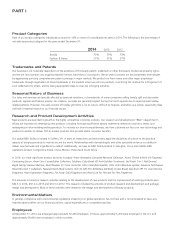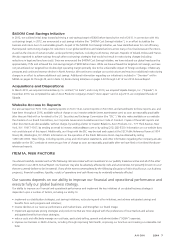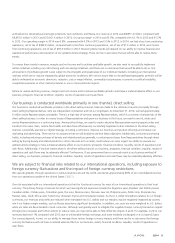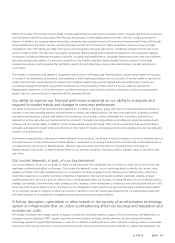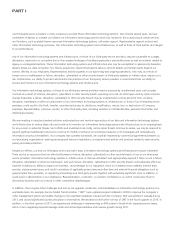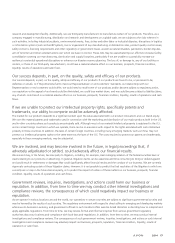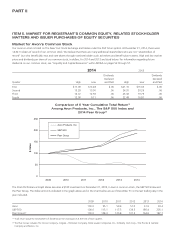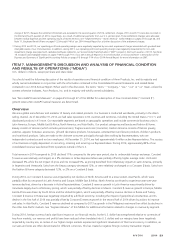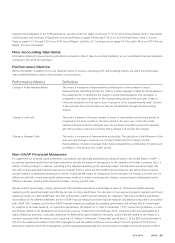Avon 2014 Annual Report Download - page 24
Download and view the complete annual report
Please find page 24 of the 2014 Avon annual report below. You can navigate through the pages in the report by either clicking on the pages listed below, or by using the keyword search tool below to find specific information within the annual report.PART I
We currently believe an ownership change has not occurred. However, in recent periods, we have experienced fluctuations in the market
price of our stock and changes in ownership by our 5% shareholders. We continue to monitor these changes.
Significant changes in pension fund investment performance, assumptions relating to pension
costs or required legal changes in pension funding rules may have a material effect on the
valuation of pension obligations, the funded status of pension plans and our pension cost.
Our funding policy for pension plans is to accumulate plan assets that, over the long run, are expected to approximate the present value of
projected benefit obligations. Our pension cost is materially affected by the discount rate used to measure pension obligations, the level of
plan assets available to fund those obligations at the measurement date and the expected long-term rate of return on plan assets. Significant
changes in investment performance or a change in the portfolio mix of invested assets can result in corresponding increases and decreases in
the valuation of plan assets, including equity and debt securities and derivative instruments, or in a change of the expected rate of return on
plan assets. Also, while our U.S. defined benefit pension plan has been closed to employees hired on or after January 1, 2015, significant
changes in the number and demographics of participants in our pension plans generally may result in additional funding obligations. A
change in the discount rate would result in a significant increase or decrease in the valuation of pension obligations, affecting the reported
funded status of our pension plans as well as the net periodic pension cost in the following fiscal years. Similarly, changes in the expected
rate of return on plan assets can result in significant changes in the net periodic pension cost of the following fiscal years. Pension funding
requirement changes under the U.S. Pension Protection Act of 2006 and related standards and regulations affect pension funding
obligations and may impose limitations on a hybrid plan’s interest crediting rate to the “market rate of return.” This may result in a
significant increase or decrease in the valuation of pension obligations affecting the reported funded status of our pension plans. Please see
“Critical Accounting Estimates – Pension and Postretirement Expense” within MD&A on pages 27 through 29 and Note 11, Employee
Benefit Plans on pages F-32 through F-40 of our 2014 Annual Report, for additional information regarding the impact of these factors on
our pension plan obligations.
Any strategic alliances, acquisitions or divestitures may expose us to additional risks.
We evaluate potential strategic alliances and acquisition prospects that would complement our current product offerings, increase the size
and geographic scope of our operations or otherwise offer growth and/or operating efficiency opportunities. Strategic alliances or
acquisitions may entail numerous risks, including:
• substantial costs, delays or other operational or financial difficulties, including difficulties in leveraging synergies among the businesses to
increase sales and obtain cost savings or achieve expected results;
• difficulties in assimilating acquired operations or products, including the loss of key employees from acquired businesses and disruption to
our direct-selling channel;
• diversion of management’s attention from our core business;
• adverse effects on existing business relationships with suppliers and customers;
• risks of entering markets in which we have limited or no prior experience; and
• reputational and other risks regarding our ability to successfully implement such strategic alliance or acquisition, including obtaining
financing which could dilute the interests of our stockholders, result in an increase in our indebtedness or both.
Our failure to successfully complete the integration of any new or acquired businesses could have a material adverse effect on our business,
prospects, financial condition, liquidity, results of operations and cash flows. In addition, there can be no assurance that we will be able to
identify suitable alliance and acquisition candidates or consummate alliances and acquisitions on favorable terms.
For divestitures, success is also dependent on effectively and efficiently separating the divested unit or business from the Company and
reducing or eliminating associated overhead costs. In cases where a divestiture is not successfully implemented or completed, the Company’s
business, prospects, financial condition, liquidity, results of operations and cash flows could be adversely affected.
The loss of, or a disruption in, our manufacturing and distribution operations could adversely
affect our business.
Our principal properties consist of worldwide manufacturing facilities for the production of Beauty products, distribution centers where
offices are located and where finished merchandise is packed and shipped to Representatives in fulfillment of their orders, and one principal


